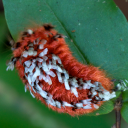How best for an animal to defend itself against attack? Some succeed by virtue of their large size or ability to fight (think of a bear). But others take a more subtle path through the production of painful or poisonous chemicals. Predators prefer to avoid these animals, because consuming them is worse than consuming nothing. Of course, this sort of chemical defense generally requires advertisement – it does an animal no good to be highly poisonous if the predator only finds out after eating you. I say generally, because you can also imagine a situation in which the predator has a bad experience with one individual animal (who dies) but then avoids other individuals of the same species, producing a group-level benefit. And you can also imagine other situations where harmless animals mimic others that are truly dangerous, with the aim of deceiving predators… the natural world is baroque in its variations.
Here are two examples of Panamanian animals that rely on chemical defenses. The first is Dendrobates auratus, commonly known as a poison dart frog. The blue-green coloration indicates its ability to secrete a highly toxic chemical, probably derived from its diet of ants.
The second example is an unknown insect species, here shown in caterpillar form. The apparently fuzzy body is actually a dense mat of stinging hairs. I hadn’t the courage to find out how much this one hurts to touch, but the red coloration is an obvious deterrent. Anyone have an identification?


